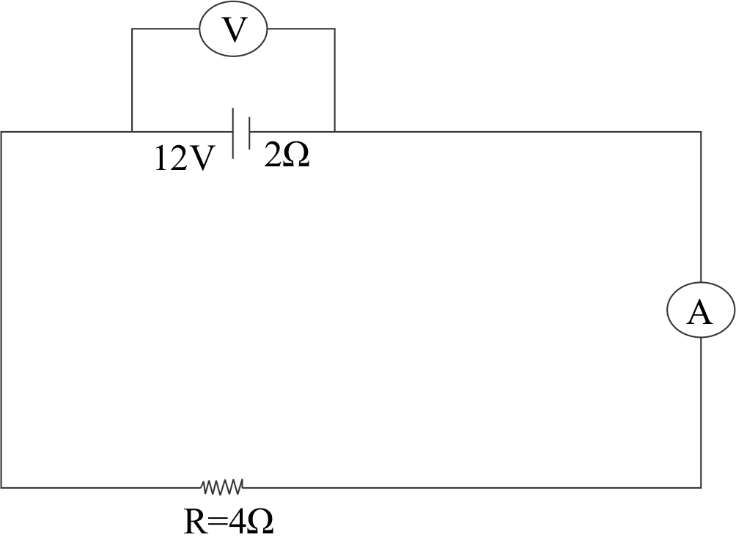
(a) The potential difference applied across a given resistor is altered so that the heat produced per second increases by a factor
(b) In the figure shown, an ammeter A and a resistor are

Answer
147k+ views
Hint: Electric potential could be a location-dependent amount that expresses the number of potential energy per unit of charge at such location. Once a Coulomb of charge (or any given quantity of charge) possesses a comparatively great quantity of potential energy at a given location, then that location is alleged to be a location of high electric potential. And equally, if a Coulomb of charge (or any given quantity of charge) possesses a comparatively tiny amount of potential energy at a given location, then that location is alleged to be a location of low electric potential.
Formula used:
Heat produced,
Where,
Voltmeter,
Where,
Complete step by Step Solution In this question, the heat is altered and that causes the heat produced by is
So they are asking the factor for which the applied potential difference changes.
Then,
Now the new potential difference will be
Then, we can write the equation as
According to the question statement,
Now we will put the values of both the heat,
We get
On further solving this equation, we get
Which implies,
Therefore we can say that the potential difference is increased by a factor
Here the total resistance
Then the ammeter reading will be,
Hence the ammeter reading will be
Now we will calculate the voltmeter required,
Substituting the values, we get
Therefore the voltmeter reading will be
Note: Voltmeters and ammeters measure the voltage and current, severally, of a circuit. Some meters in automobile dashboards, digital cameras, cell phones, and tuner-amplifiers are voltmeters or ammeters.
Formula used:
Heat produced,
Where,
Voltmeter,
Where,
Complete step by Step Solution In this question, the heat is altered and that causes the heat produced by is
So they are asking the factor for which the applied potential difference changes.
Then,
Now the new potential difference will be
Then, we can write the equation as
According to the question statement,
Now we will put the values of both the heat,
We get
On further solving this equation, we get
Which implies,
Therefore we can say that the potential difference is increased by a factor
Here the total resistance
Then the ammeter reading will be,
Hence the ammeter reading will be
Now we will calculate the voltmeter required,
Substituting the values, we get
Therefore the voltmeter reading will be
Note: Voltmeters and ammeters measure the voltage and current, severally, of a circuit. Some meters in automobile dashboards, digital cameras, cell phones, and tuner-amplifiers are voltmeters or ammeters.
Latest Vedantu courses for you
Grade 10 | MAHARASHTRABOARD | SCHOOL | English
Vedantu 10 Maharashtra Pro Lite (2025-26)
School Full course for MAHARASHTRABOARD students
₹33,300 per year
EMI starts from ₹2,775 per month
Recently Updated Pages
How to find Oxidation Number - Important Concepts for JEE

How Electromagnetic Waves are Formed - Important Concepts for JEE

Electrical Resistance - Important Concepts and Tips for JEE

Average Atomic Mass - Important Concepts and Tips for JEE

Chemical Equation - Important Concepts and Tips for JEE

Concept of CP and CV of Gas - Important Concepts and Tips for JEE

Trending doubts
JEE Main 2025 Session 2: Application Form (Out), Exam Dates (Released), Eligibility, & More

JEE Main Exam Marking Scheme: Detailed Breakdown of Marks and Negative Marking

JEE Main 2025: Derivation of Equation of Trajectory in Physics

JEE Main Participating Colleges 2024 - A Complete List of Top Colleges

Electric Field Due to Uniformly Charged Ring for JEE Main 2025 - Formula and Derivation

Electric field due to uniformly charged sphere class 12 physics JEE_Main

Other Pages
JEE Advanced Marks vs Ranks 2025: Understanding Category-wise Qualifying Marks and Previous Year Cut-offs

JEE Advanced 2025: Dates, Registration, Syllabus, Eligibility Criteria and More

JEE Advanced Weightage 2025 Chapter-Wise for Physics, Maths and Chemistry

Degree of Dissociation and Its Formula With Solved Example for JEE

Learn About Angle Of Deviation In Prism: JEE Main Physics 2025

Ideal and Non-Ideal Solutions Raoult's Law - JEE




